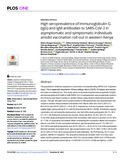| dc.contributor.author | Awandu, Shehu Shagari | |
| dc.contributor.author | Ochieng, Alfred Ochieng | |
| dc.contributor.author | Onyango, Benson | |
| dc.contributor.author | Magwanga, Richard Odongo | |
| dc.contributor.author | Were, Pamela | |
| dc.contributor.author | Ochung, Angeline Atieno | |
| dc.contributor.author | Okumu, Fredrick | |
| dc.contributor.author | Oloo, Marceline Adhiambo | |
| dc.contributor.author | Katieno, Jim Seth | |
| dc.contributor.author | Lidechi, Shirley | |
| dc.contributor.author | Ogutu, Fredrick | |
| dc.contributor.author | Awuor, Dorothy | |
| dc.contributor.author | Kirungu, Joy Nyangasi | |
| dc.contributor.author | Orata, Francis | |
| dc.contributor.author | Achieng, Justine | |
| dc.contributor.author | Oure, Bonface | |
| dc.contributor.author | Nyunja, Regina | |
| dc.contributor.author | Muok, Eric M. O. | |
| dc.contributor.author | Munga, Stephen | |
| dc.contributor.author | Estambale, Benson | |
| dc.date.accessioned | 2023-01-18T11:43:17Z | |
| dc.date.available | 2023-01-18T11:43:17Z | |
| dc.date.issued | 2022-12-22 | |
| dc.identifier.uri | https://journals.plos.org/plosone/article?id=10.1371/journal.pone.0272751 | |
| dc.identifier.uri | https://doi.org/10.1371/journal.pone.0272751 | |
| dc.identifier.uri | http://ir-library.mmust.ac.ke:8080/xmlui/handle/123456789/2161 | |
| dc.description.abstract | The population’s antibody response is a key factor in comprehending SARS-CoV-2 epidemiology. This is especially important in African settings where COVID-19 impact, and vaccination rates are relatively low. This study aimed at characterizing the Immunoglobulin G (IgG) and Immunoglobulin M (IgM) in both SARS-CoV-2 asymptomatic and symptomatic individuals in Kisumu and Siaya counties in western Kenya using enzyme linked immunosorbent assays. The IgG and IgM overall seroprevalence in 98 symptomatic and asymptomatic individuals in western Kenya between December 2021-March 2022 was 76.5% (95% CI = 66.9–84.5) and 29.6% (95% CI = 20.8–39.7) respectively. In terms of gender, males had slightly higher IgG positivity 87.5% (35/40) than females 68.9% (40/58). Amidst the ongoing vaccination roll-out during the study period, over half of the study participants (55.1%, 95% CI = 44.7–65.2) had not received any vaccine. About one third, (31.6%, 95% CI = 22.6–41.8) of the study participants had been fully vaccinated, with close to a quarter (13.3% 95% CI = 7.26–21.6) partially vaccinated. When considering the vaccination status and seroprevalence, out of the 31 fully vaccinated individuals, IgG seropositivity was 81.1% (95% CI = 70.2–96.3) and IgM seropositivity was 35.5% (95% CI = 19.22–54.6). Out of the participants that had not been vaccinated at all, IgG seroprevalence was 70.4% (95% CI 56.4–82.0) with 20.4% (95% CI 10.6–33.5) seropositivity for IgM antibodies. On PCR testing, 33.7% were positive, with 66.3% negative. The 32 positive individuals included 12(37.5%) fully vaccinated, 8(25%) partially vaccinated and 12(37.5%) unvaccinated. SARs-CoV-2 PCR positivity did not significantly predict IgG (p = 0.469 [95% CI 0.514–4.230]) and IgM (p = 0.964 [95% CI 0.380–2.516]) positivity. These data indicate a high seroprevalence of antibodies to SARS-CoV-2 in western Kenya. This suggests that a larger fraction of the population was infected with SARS-CoV-2 within the defined period than what PCR testing could cover. | en_US |
| dc.language.iso | en | en_US |
| dc.publisher | PLOS ONE | en_US |
| dc.subject | High seroprevalence, Immunoglobulin G (IgG), IgM, antibodies, SARS-CoV-2, asymptomatic, symptomatic, individuals, amidst, vaccination, roll-out | en_US |
| dc.title | High seroprevalence of Immunoglobulin G (IgG) and IgM antibodies to SARS-CoV-2 in asymptomatic and symptomatic individuals amidst vaccination roll-out in western Kenya | en_US |
| dc.type | Article | en_US |

